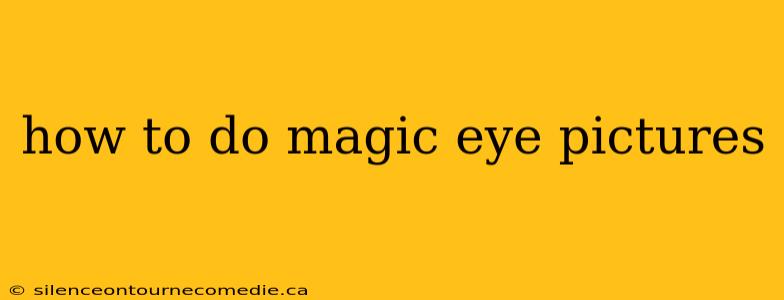Meta Description: Unlock the secrets of Magic Eye pictures! This comprehensive guide provides a step-by-step tutorial on how to see the hidden 3D images, along with tips and tricks for mastering this mesmerizing visual puzzle. Learn different techniques and discover the fascinating science behind these stereograms.
Magic Eye pictures, also known as autostereograms, are mesmerizing images that reveal hidden 3D scenes when viewed correctly. For many, the initial experience can be frustrating. But with a little practice and the right techniques, anyone can learn to see these fascinating images. This guide will teach you exactly how.
Understanding Magic Eye Pictures
Before we dive into the techniques, let's understand what makes Magic Eye pictures work. These aren't actually 3D images in the traditional sense. They are a type of stereogram, a single image containing two slightly offset versions of the same picture. Your brain interprets these offsets as depth, creating the illusion of a three-dimensional image.
How to See a Magic Eye Picture: Techniques
Several techniques can help you "unlock" the hidden image within a Magic Eye picture. Experiment with these methods to find what works best for you:
Method 1: The Cross-Eyed Technique
- Hold the image: Hold the Magic Eye picture at arm's length.
- Focus beyond: Instead of focusing on the picture itself, focus on a point behind the image, as if looking through it.
- Relax your eyes: Let your eyes relax and slightly cross. You should start to see a blurry double image.
- Adjust your focus: Slowly adjust your focus and eye position until the double image merges into a single, clear 3D image. This may take some time and practice.
Method 2: The Wall-Eyed Technique (More Difficult)
This technique is generally considered more difficult to master than the cross-eyed technique.
- Hold the image: Hold the Magic Eye picture at arm's length.
- Focus on a point in front: Focus on a point in front of the image, closer to your face than the picture.
- Relax and diverge your eyes: Let your eyes relax and slightly diverge, as if you are looking at something far away.
- Adjust your focus: As with the cross-eyed technique, you'll need to fine-tune your focus and eye position to see the 3D image. The image will appear to float in front of the picture.
Tips for Success
- Distance: Experiment with different distances between your eyes and the image. The optimal distance varies depending on the picture and your eyesight.
- Lighting: Good lighting is crucial. Avoid harsh glare or shadows.
- Patience: Don't get discouraged if you don't see the image immediately. It can take time and practice to master the techniques.
- Blurry Image: If you see a blurry double image, you're on the right track. Continue to adjust your focus until the images merge.
- Try Different Pictures: Some Magic Eye pictures are easier to see than others. Start with simpler images and gradually move on to more complex ones.
Troubleshooting Common Problems
- I can't see anything: Relax your eyes and try again. Don't strain your eyes. Try adjusting the distance between you and the image. Different techniques work for different people.
- I see a double image, but it won't merge: Try slightly adjusting your focus and eye position. Small movements can make a big difference.
- My eyes hurt: If you experience eye strain, stop and rest your eyes. Don't force it.
The Science Behind Magic Eye Pictures
Magic Eye pictures are based on the principle of binocular disparity—the slight difference in the images seen by each eye. Your brain uses this disparity to perceive depth. The patterns in Magic Eye pictures create this disparity, triggering your brain to interpret the image in 3D.
Beyond the Basics: Finding More Magic Eye Images
Once you've mastered the techniques, you can find countless Magic Eye pictures online. Many websites and apps offer a wide variety of images, from simple shapes to complex landscapes and scenes.
Mastering Magic Eye pictures is a rewarding experience. It's a fun visual puzzle that combines science and perception, offering a unique way to experience images. So keep practicing, and soon you'll be amazed by the hidden 3D worlds you discover!
